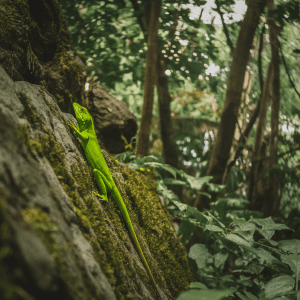Introduction: The Importance of Cooling Mechanisms in Lizards
Ever wondered how lizards manage to keep cool under the scorching sun? Let me enlighten you on the fascinating world of lizard thermoregulation.
Picture this: you’re strolling through a tropical forest, and suddenly, you spot a vibrant green lizard perched on a sunlit rock. Have you ever stopped to think about how it manages to stay cool in that blazing heat?
Lizards are masters of adapting to their environment. They have a few tricks up their scaly sleeves when it comes to regulating their body temperature. From basking in the sun to seeking shade under a leafy canopy, these reptiles know how to play it cool.
One interesting fact about lizards is that they can adjust their behavior based on the temperature around them. It’s like they have an internal thermostat that guides them on when to soak up the sun’s warmth and when to retreat to a shady spot.
Imagine if we humans had that ability! We’d never have to worry about sweating or shivering again. But alas, we’re not as adaptable as our lizard friends.
As we delve deeper into the world of lizard cooling mechanisms, you’ll discover the intricate dance between these reptiles and their environment. So buckle up and get ready to journey into the fascinating realm of lizard thermoregulation.
Understanding Lizard Behavior in Regulating Body Temperature
Understanding Lizard Behavior in Regulating Body Temperature
Lizards, those scaly sun-soakers, have some pretty cool tricks up their sleeves when it comes to beating the heat. Ever noticed how they’re often found lounging in the sun, looking like they’re catching some rays? That’s not just for relaxation – it’s all part of their master plan to keep their body temperature in check.
Basking is like their version of a tropical vacation, except instead of sipping on a fruity drink, they’re soaking up the sun’s warmth. It’s their way of absorbing heat to kickstart their metabolism and keep their energy levels up. Just imagine if we could recharge our batteries by sunbathing!
But what about when things get a little too toasty? That’s where seeking shade comes into play. Lizards are nature’s experts at finding the coolest spots to chill out when the sun gets too intense. It’s like they have their own built-in temperature control system, always knowing when it’s time to retreat to the shade.
And let’s not forget about panting – the lizard version of sweating. When they need to cool down in a hurry, they’ll open their mouths wide and take quick breaths to release excess heat. It’s like their own little air conditioning unit, keeping them comfortable even in the hottest of climates.
So next time you spot a lizard basking in the sun or darting into the shadows, remember – they’re not just catching some rays, they’re masters of thermal regulation in the animal kingdom. It’s a fascinating world out there, filled with creatures who have their own unique ways of staying cool.
Basking: A Key Method for Lizards to Stay Cool
In the scorching world of lizards, staying cool is a survival art form. Picture this: a lizard, basking lazily on a sun-drenched rock, soaking up the warmth. But wait, this isn’t just about lounging around. Basking is their secret weapon for regulating body temperature. It’s like their own personal solar panel, absorbing the sun’s rays to rev up their internal thermostat.
And when the heat becomes too intense, what do they do? They seek refuge in the comforting embrace of shade, a sanctuary from the blazing sun. It’s their instinctive response to avoid overheating, a natural behavior honed through millions of years of evolution.
But here’s the kicker – lizards are not all about leisurely sunbathing. When the mercury rises, they kick it up a notch with a cool trick: panting. Yes, you heard that right. Lizards pant like a dog, but not out of exhaustion. It’s their clever way of releasing excess heat, like a built-in air conditioning system.
Imagine being able to cool down just by panting! It’s like having a portable cooling unit wherever you go. So next time you see a lizard basking in the sun or seeking shade under a leafy canopy, remember the fascinating cooling mechanisms at play. These reptilian wonders have mastered the art of beating the heat, and their techniques are nothing short of awe-inspiring.
Seeking Shade: How Lizards Find Relief from the Heat
Basking: A Key Method for Lizards to Stay Cool
Picture this: a lizard lazily sprawled out on a rock, soaking up the sun’s rays like a sunbather on a tropical beach. But hey, this lizard isn’t just working on its tan – it’s actually using a clever technique to regulate its body temperature.
When lizards bask, they are essentially sunbathing with a purpose. By absorbing the warmth from the sun, they can raise their body temperature and kickstart their metabolism. It’s like hitting the snooze button on a cold morning – except for lizards, it’s a vital survival strategy.
Now, here’s where it gets interesting. Have you ever noticed how some lizards change their positions while basking? It’s not just about catching some rays from different angles. They’re actually masterfully balancing between heating up and cooling down. It’s like a reptilian dance of thermoregulation!
Imagine being able to control your body temperature simply by moving to a sunny or shady spot. Lizards have this down to a science. They know exactly when to bask to warm up and when to seek shade to cool off.
So, next time you spot a lizard lounging in the sun, remember that it’s not just chilling out – it’s engaging in a complex and fascinating process of thermal regulation. It’s nature’s way of showing us that sometimes the simplest actions can have the most profound effects.
Panting: The Cooling Process of Lizards
Basking is like a lizard’s version of a beach day, but with a life-saving purpose. Imagine this: a lizard, sprawled out under the warm sun, soaking in all that heat like a solar panel. It’s not just about catching some rays; it’s about staying cool in the scorching heat of their environment. Picture yourself on a summer day, seeking out a shady spot under a tree to escape the blazing sun. That’s what lizards do too! They’re masters at finding relief from the heat by simply moving to a cooler, shaded area. Panting may sound like something your dog does after a long run, but for lizards, it’s a cooling mechanism. They open their mouths and breathe rapidly, releasing excess heat to regulate their body temperature. It’s like their own little air conditioning system! Lizards have some serious skills when it comes to keeping cool. They’ve got it all figured out: basking, seeking shade, panting – it’s all part of their survival toolkit. Next time you see a lizard sunning itself on a rock, take a moment to appreciate the incredible ways they adapt to their environment. It’s a reminder that nature has its own clever solutions to life’s challenges.
Other Cooling Techniques Used by Lizards
Alright, let’s dive into the fascinating world of how lizards cool themselves down. Picture this: a scorching hot day in the desert, and a little lizard is out basking in the sun. It may seem counterintuitive, but that lizard is actually using the sun’s warmth to regulate its body temperature. Yep, you heard that right!
Now, let me hit you with a cool fact about lizards and their basking behavior. Did you know that some lizards can adjust the angle of their bodies to maximize sun exposure and absorb just the right amount of heat? It’s like they have their own little solar panels built-in!
When it comes to seeking shade, lizards are like expert hide-and-seek players. They know exactly where to find those shady spots to escape the blazing heat. It’s like a game of survival for them, and they play it oh so well.
Panting, on the other hand, is a lizard’s way of saying, “Whew, it’s getting hot in here!” Just like a dog sticking out its tongue to cool down, lizards pant to release excess heat and keep their cool in the heat of the moment.
So, next time you see a lizard sunbathing or darting into the shadows, remember the clever ways these little reptiles stay chill in the face of extreme temperatures. It’s like they’ve got their own secret cooling techniques that have stood the test of time. Who knew these scaly creatures were such masters of thermoregulation?
Environmental Factors Impacting Lizards’ Cooling Strategies
Imagine walking through a sun-kissed desert and stumbling upon a majestic lizard basking in the heat. Have you ever wondered what goes on in the mind of this seemingly laid-back creature? Well, let’s delve into the fascinating world of environmental factors impacting how lizards cool themselves down.
Lizards, with their scaly bodies and mesmerizing movements, have mastered the art of adapting to their surroundings. Picture this: a lizard darting from the scorching sun into the cool embrace of a shaded rock. It’s a survival technique that involves a delicate dance with nature.
Now, here’s a mind-blowing fact for you: did you know that lizards can adjust their body temperatures based on the environment they are in? Yes, these cold-blooded creatures are experts at using their surroundings to regulate their internal heat levels.
But what happens when the environment becomes too harsh for even the most resilient lizard? This is where understanding the environmental factors impacting lizards’ cooling strategies becomes crucial. From extreme heatwaves to disappearing habitats, lizards face challenges that test their adaptive abilities.
So, next time you encounter a lizard basking in the sun or seeking shelter in the shade, take a moment to appreciate the intricate balance between nature and survival. The world of lizards is not just a fascinating spectacle—it’s a testament to the resilience and adaptability of life in the wild.
Benefits of Studying Lizards’ Cooling Mechanisms
Let’s dive deeper into the benefits of studying lizards‘ cooling mechanisms. Picture this – you’re wandering through a sun-kissed desert, and suddenly, a vibrant lizard scurries past you. Have you ever wondered how these fascinating creatures manage to beat the scorching heat? Well, it all boils down to their ingenious cooling strategies.
Lizards are masters of adaptation, utilizing a range of techniques to maintain their body temperature. By studying their cooling behaviors, researchers gain valuable insights into how these resilient creatures thrive in diverse environments. It’s like uncovering nature’s own survival manual!
Imagine this: lizards facing the challenge of extreme heat must constantly adjust their behavior to avoid overheating. This dynamic interplay between environmental factors and lizard behavior showcases the intricate balance of nature. Understanding this delicate equilibrium can offer a glimpse into the remarkable resilience of these tiny reptiles.
Ever wondered how lizards’ cooling mechanisms could hold the key to sustainable living practices? By learning from these natural experts, we may discover innovative ways to adapt to a changing climate. How can we apply their cooling strategies to enhance our own environmental sustainability efforts? The possibilities are as endless as the desert horizon.
So, the next time you spot a lizard basking in the sun, take a moment to appreciate the hidden world of thermal regulation that unfolds before your eyes. Their cooling techniques are not just survival strategies but valuable lessons in resilience and adaptation for us all.
Conservation Implications of Lizards’ Cooling Behavior
Have you ever wondered about the hidden world of lizards and their fascinating cooling techniques? These creatures may seem small and unassuming, but their ability to regulate body temperature is nothing short of remarkable. Let me share a little anecdote with you – I once observed a lizard basking in the warm sun, its scales glistening as it absorbed the heat. It was a mesmerizing sight, highlighting the intricate ways in which these creatures adapt to their environment.
Now, let’s delve into the practical implications of understanding how lizards cool themselves down. By studying their behavior, we gain valuable insights into the broader ecosystem and the delicate balance of nature. Imagine if we could apply some of these cooling strategies to our own lives – seeking shade when things get too hot, or taking a moment to bask in the warmth of the sun for rejuvenation. It’s a thought-provoking concept, isn’t it?
As we uncover more about lizards’ cooling mechanisms, we also come face to face with the challenges they face in an ever-changing world. Climate change, habitat loss, and human interference all pose threats to these remarkable creatures. How can we protect them and ensure their survival for generations to come? It’s a question that invites us to reflect on our role in preserving the diversity of life on our planet.
So, the next time you spot a lizard sunbathing on a rock or darting into the shadows, take a moment to appreciate the intricate dance of nature unfolding before your eyes. Who knows, you might just discover a newfound respect for these tiny but tenacious creatures and the vital role they play in the tapestry of life.
Conclusion: Appreciating the Adaptations of Lizards for Thermal Regulation
Lizards are truly fascinating creatures, especially when it comes to how they cool themselves down. Picture this: a lizard lazily basking in the warm sun, absorbing its rays to regulate their body temperature. Did you know that some lizards can adjust their color to absorb or reflect sunlight more efficiently? It’s like having a built-in thermostat!
Now, when the heat becomes too much to handle, lizards exhibit some quirky behaviors. Seeking shade becomes their mission, as they scurry off to cooler spots to avoid overheating. Imagine being so in tune with nature that you instinctively know where to find relief from the scorching sun.
And let’s not forget about panting. Yes, lizards pant just like dogs! This process allows them to release excess heat and maintain their ideal body temperature. It’s like watching a tiny reptilian symphony of cooling mechanisms in action.
But have you ever wondered how environmental factors influence these cooling strategies? From the type of habitat they live in to the time of day, every aspect plays a role in how lizards stay cool. It’s a delicate dance between nature and adaptation.
So, the next time you spot a lizard sunbathing or darting for cover, take a moment to appreciate the intricate ways these creatures have mastered the art of thermal regulation. It’s a reminder of the incredible diversity and resilience of life on our planet.




